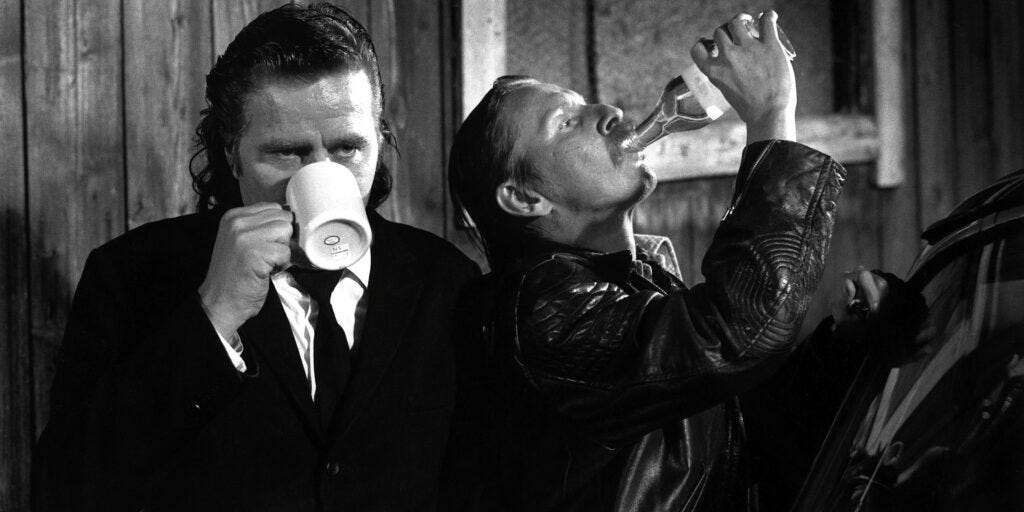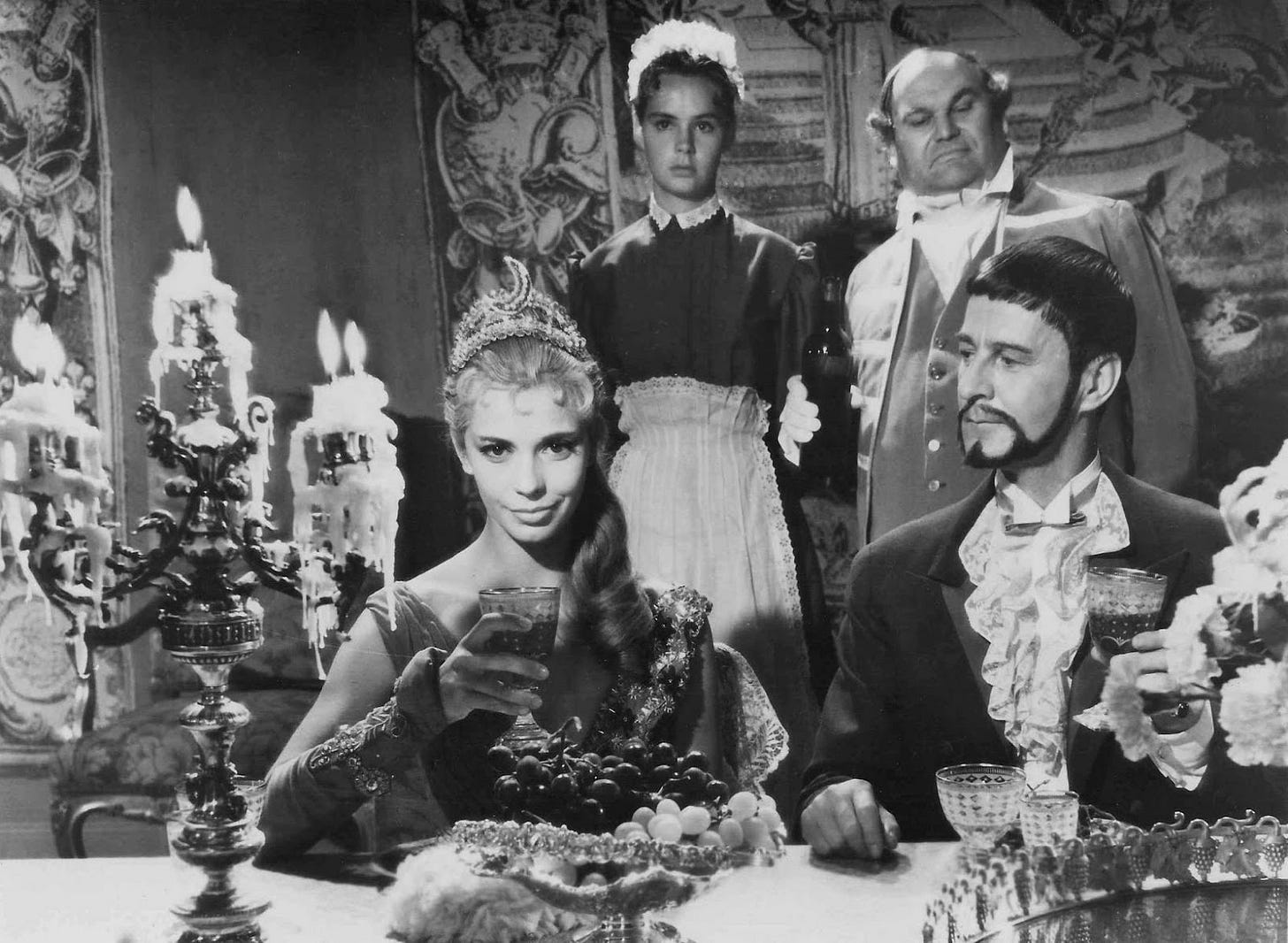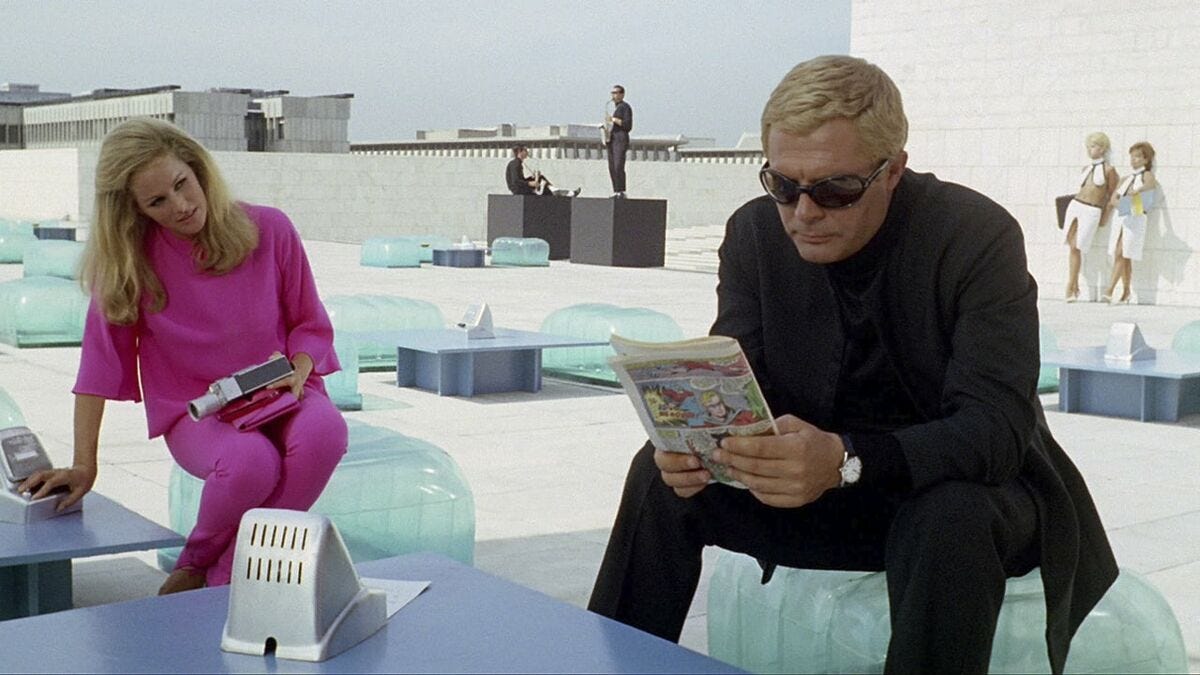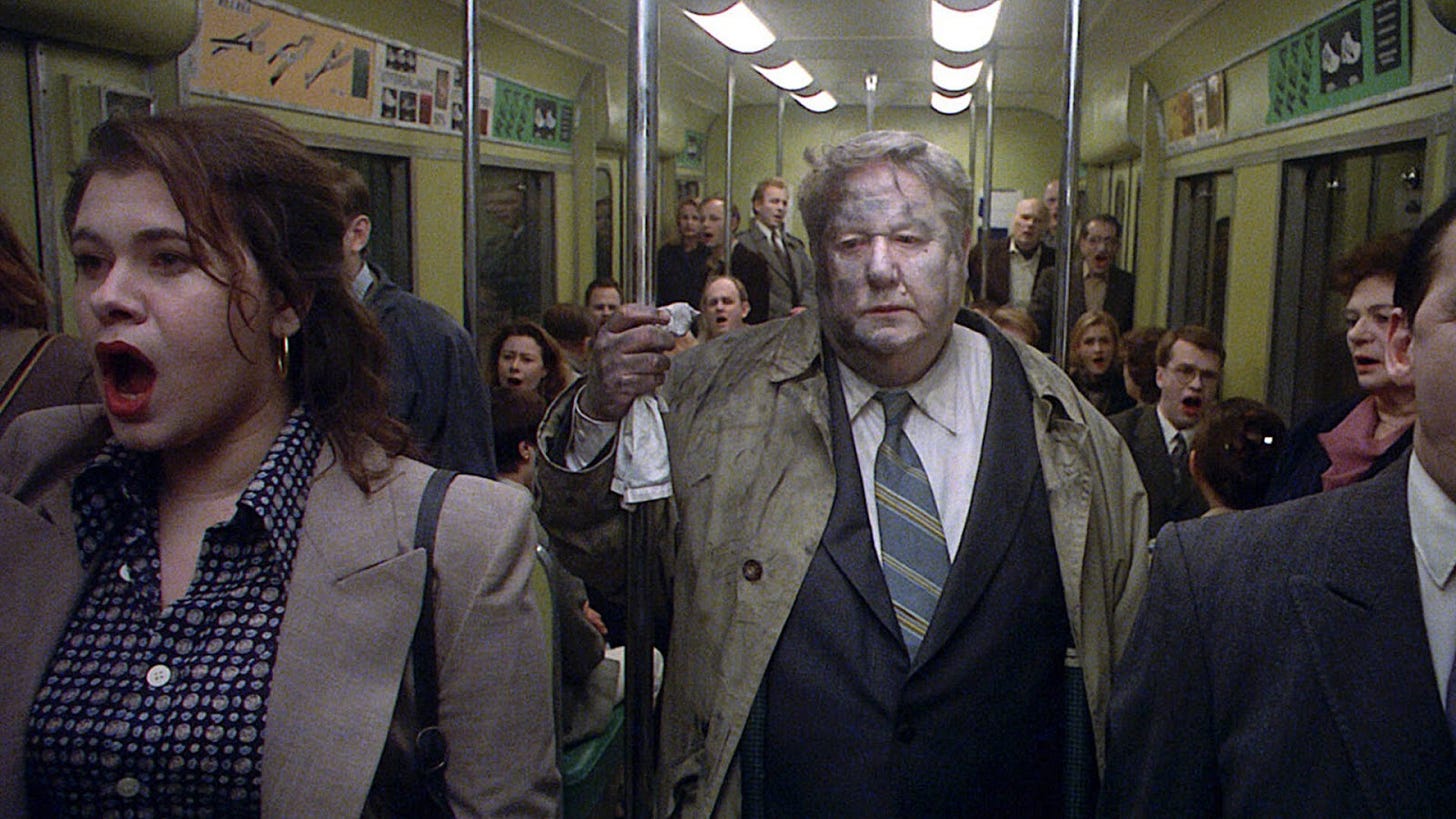April is upon us, and you know what that means: I’m feverishly rubbing my palms together and smacking my lips as I comb through my Letterboxd logs for the month of March. I’m still not back to my regular shmegular once-a-night movie-watching cadence (learning the backend technicalities of podcast editing will do that to you), but hey — quality over quantity is the name of the game. Or at least, it’s my game, since these days my brain short-circuits after too much cinephilia and starts craving Fallout: New Vegas playthroughs for the umpteenth time.
Anyway! You’re here to get in, get out, and smash that watchlist button, right? Without further ado, here are my top-rated bangers for March.
Something, something… let’s rewind and revive, shall we?
Danger: Diabolik (Mario Bava, 1968)
Leave it to Mario Bava to make one of the most stylish and lush comic book adaptations ever put to celluloid. Danger: Diabolik manages to be absurd, romantic, and rebellious; plus, nobody has ever looked hotter rolling around in a pile of cash (I'm being serious). On the surface, it's a candy-colored caper filled with underground lairs, outrageous heists, and planes with trap doors. But beneath that glossy veneer lies a sly, subversive spirit.
Set in a vibrant, hyper-stylized world, Danger: Diabolik follows the too-cool-for-school, latex-clad master thief Diabolik (John Phillip Law) and his equally glamorous partner Eva Kant (Marisa Mell) as they pull off a series of increasingly outrageous heists. Always one step ahead of the law — namely Inspector Ginko (Michel Piccoli!!) — Diabolik and Eva live lavishly (albeit underground), wreak havoc on corrupt institutions, and stay madly in love while doing it. What unfolds is a psychedelic, pop-art crime fantasy, full-stop.
Tapped by Dino De Laurentiis after booting Seth Holt, Bava was instantly drawn to the character of Diabolik. Known for his beautifully violent gialli, Bava wanted to stay faithful to the comic’s darker tone — something that clashed with De Laurentiis’ more audience-friendly vision. As Law put it, “After a lot of arguing back and forth, it became a sort of hybrid.”
Even though they verbally sparred at times, it's reported that Bava got along relatively well with the famed producer. The problem? De Laurentiis was often unavailable, working on however many other pictures he had going on (as an aside, Danger: Diabolik was produced alongside Barbarella — where Law also appeared as Pygar). Though endlessly frustrated, Bava leaned into what he did best: inventiveness under constraint. Bava, famously a magician of low-budget visual trickery, was pushed into a corner. While Diabolik is considered one of the biggest budgets Bava worked with in his career, De Laurentiis refused to greenlight any changes unless he was told — nay, intricately walked through — every detail, something that proved to be borderline impossible if he was nowhere to be found. "Imagine how I had to get by, inventing everything with trickery, because the production company gave me nothing to work with! Nothing!" Bava opined later on.
Weirdly enough? It works. What Bava ended up doing (and is an utter delight to see on screen) was utilizing cardboard cutouts, glass matte paintings, and forced perspective to construct out-of-this-world environments that feel both tangible and surreal. From Diabolik's underground lair (complete with a gigantic pool) to the pop-art nightclub dripping in 1960s kitsch, every set dazzles; even more so when Law and Mell appear on screen together. Their romance is central, not an afterthought: sensual, sincere, and.... oddly domestic?
Beyond the eye candy, there’s a cheeky critique of institutions woven into the chaos. Bava softened the edges of his antiheroes, painting Diabolik as a bit of a comic book Robin Hood. He doesn't rob banks just because; he's out to disrupt power structures and humiliate those in charge. Diabolik rebels against bureaucracy, taking a surprisingly principled approach — even when he's blowing up tax buildings.
It’s part Bond, part Fantômas, part Adam West-era Batman, but all filtered through Bava’s eye for color and trickery, where every frame plays like a comic panel mid-pop. There’s a rebellious joy in how Bava elevates pulp into pop-art cinema.
PS: Tim Lucas’ Mario Bava: All the Colors of the Dark is essential supplemental reading if you want to dive deeper into the film (or Bava’s work in general) – a lot of my research comes from here, too.
You can stream Danger: Diabolik on Kanopy, AppleTV, and YouTube.
Take Care of Your Scarf, Tatjana (Aki Kaurismäki, 1994)
Of the seven Aki Kaurismäki films I’ve seen so far, this one ranks surprisingly high — and I wasn’t expecting that. I put on Take Care of Your Scarf, Tatjana when I was tired, searching for something short and quiet. I didn’t think I’d be so wrapped up in it in just 62 minutes.
The plot is simple: two Finnish men, Valto (Mato Valtonen) and Reino (the late, great Matti Pellonpää), decide to take a spontaneous road trip. There’s no plan beyond escape… or maybe just to drink. Valto can’t stop brewing pots of coffee, and Reino treats vodka like water. At one point, Valto drinks an entire pot straight from the spout like it’s no big deal. The absurdity is played deadpan (classic Kaurismäki), but there’s something quietly tragic beneath it, too.
Along the way, they pick up two women, a Russian and an Estonian, who ask them for a lift to the harbor. And that’s… it. That’s the story. But as always with Kaurismäki, it’s not the plot that matters: it’s what you feel.
Tatjana is full of Kaurismäki’s usual beats: melancholic landscapes and faces that seem carved out of a long winter. His characters barely speak, but it’s clipped and hesitant when they do — like they’ve forgotten how. There’s something so deeply moving about how awkwardly they fumble through connection, especially Reino, whose tentative flirtations are cripplingly endearing.
It feels like catching up with old friends at a dive bar after a long, exhausting day — partly because of the familiar cast, but mostly because of the warmth Kaurismäki finds in life’s gray corners. There’s always a moment of musical catharsis in his work that makes me smile, too, and this one’s no exception.
Pellonpää’s presence here moves me. He passed away just a year after this film was made, far too soon at the age of 44. There’s a quiet power to how he carries himself; a slumped gentleness I find unforgettable. It adds even more poignancy to Kaurismäki’s already sparse compositions.
It may be a breezy watch on paper, but Take Care of Your Scarf, Tatjana sits comfortably among my favorite road movies. Between the absurdist humor and deadpan detours, it left me thinking about addiction, longing, and how even a cup of coffee (consumed obsessively) can become a metaphor for what we carry, even when trying to move on.
You can stream Take Care of Your Scarf, Tatjana on MUBI India.
Smiles of a Summer Night (Ingmar Bergman, 1955)
I knew about Smiles of a Summer Night before watching it, aware it was born from one of the bleakest chapters in Ingmar Bergman’s life. What stunned me is that, watching it now, you’d never guess. Smiles is charming, nimble, and, quite frankly, genuinely hilarious. A sex comedy (I need you to know that, as typing this, I accidentally wrote “sexy comedy,” and kind of like that more) set in early 20th-century Sweden, it’s filled with tangled romances, betrayals, and longings, harmonizing together in perfect unison. It’s a brilliant reminder that Bergman was, in fact, a funny guy (The Seventh Seal, for instance, released just two years later, also has more laughs than people give it credit for – something I’ll always stress).
But for all the romantic scheming and farcical entanglements, the unexpected tenderness stuck with me most, especially in one loving scene between Anne (Ulla Jacobsson) and Petra (Harriet Andersson). Their friendship feels refreshingly expectation-free in a film where nearly every relationship is driven by manipulation or yearning. Anne, the virginal young wife of an older man, and Petra, her lusty and far more experienced maid, are polar opposites. Yet when they’re together, it’s all giggles — girls being girls, delighting in their shared disdain for men (real). Pockets of sincerity like this one always make my heart sing.
That said, it’s also striking how effortlessly this slots into the larger Bergman canon. Yes, it’s more playful than what we’re accustomed to, but the themes are all still there: the painful mess of love. The ways people use each other to feel wanted. The emotional battleground of desire. Even the film’s most morbid turn — one I won’t spoil — is played with such a light touch that it barely disrupts its rhythm. Which isn’t to say it doesn’t matter. Rather, it speaks to how human fragility is embedded in every one of Bergman’s stories, even the funny ones.
“Love is a loathsome business.”
You can stream Smiles of a Summer Night on the Criterion Channel, AppleTV, or YouTube.
The 10th Victim (Elio Petri, 1965)
Of all the films I watched this month, The 10th Victim left me exhilarated and salivating for more — not just because of what’s onscreen, but because of everything boiling beneath its surface. Imagine a glam, mod, bullet-bra’d (I see you, Austin Powers) dystopia where murder is gamified, love is transactional, and society runs on spectacle. And now imagine trying to make that film while being micromanaged by Carlo Ponti.
Based on Robert Sheckley’s short story Seventh Victim, Petri envisioned a scathing political sci-fi: one where love hadn’t existed for centuries and society had fully commodified death. But once the Ponti stepped in (with zero interest in sci-fi but peak interest in main star Marcello Mastroianni), the film was rewritten for mass appeal. Petri, ever the firebrand, adapted… as best he could.
What’s remarkable is how much of his original vision still bleeds through: the hollow romance, the sleek but soulless set design, the chilling offhand comments about America’s lax gun laws (eerily prophetic, to say the least). The 10th Victim may have been compromised, but its commentary is razor-sharp — especially when you know what it could’ve been.
A full deep-dive on this one is coming next week. I can’t wait to yap about this further.
You can stream/rent The 10th Victim on YouTube and AppleTV.
Songs from the Second Floor (Roy Andersson, 2000)
March saw me diving into the works of Roy Andersson! What a strange and darkly hilarious little movie this was. This was my second watch, after A Pigeon Sat on a Branch Reflecting on Existence, and while that one impressed me, I found Songs from the Second Floor the more resonant of the two.
Less a narrative and more a tapestry of existential despair, it’s composed of loosely connected tableaux, each one static, pale, and absurd. I loved the concept of perpetual gridlock in every frame. You have the literal traffic jam that opens the film, but you also have the spiritual stagnation of the people caught within it. No one seems able to move forward, emotionally or otherwise.
But for all its melancholy, Songs isn’t joyless. Far from it. Andersson can make you laugh just as you start to feel that all hope is lost. Each scene is so meticulously composed and bone-dry in its humor (a pal recommended this to me knowing I’m a fan of Kaurismäki) that you can’t help but giggle; even when it feels like the punchline might be humanity itself.
I was particularly struck by how human this film feels. The characters aren’t so much caricatures as they are stand-ins for something achingly real. They stumble, they suffer. Every image is laced with absurdity and sorrow in equal measure. What does it mean to sit down in a world that demands constant motion, constant growth? Maybe it's a surrender. Perhaps it's just exhaustion. “Beloved is the one who sits down.”
Andersson’s style won’t be for everyone, sure. The pacing is glacial, and the emotional beats are deliberately muffled. For me? I lap this sort of stuff up. Simply put, he captures the human experience, no?
You can stream Songs from the Second Floor on the Criterion Channel.
And that’s all from me today, folks! As always, you can keep up with everything I’m watching over on Letterboxd ☻












The New Vegas escapism was me 3 months ago. Just tell yourself it's important prep work for season 2 of the show : )